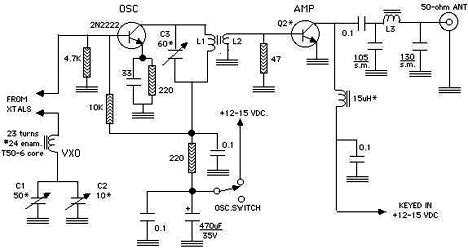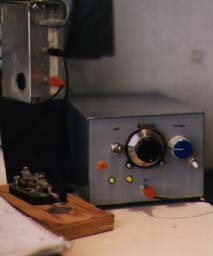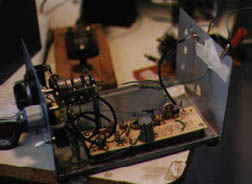


15 METER VXO-TUNED
CW TRANSMITTER
Cost estimate: $25 (excluding crystals)
An easy-to-build and affordable CW rig that puts out about 500 milliwatts on 15 meters, this simple modification of W7ZOI's classic two-stage "Universal QRP Transmitter" (also known as the "Little Joe" ) features a VXO circuit that "warps" each crystal frequency by as much as 10kHz or more for increased flexibility. This transmitter's oscillator runs throughout the transmit period; voltage is keyed to the amplifier section while the oscillator is on. After construction, tuneup is a snap: connect a 12-15 VDC power source and 50-ohm dummy load or RF wattmeter and tune a monitoring receiver to the anticipated transmit frequency. Flip on the oscillator switch and adjust C3 until a tone is heard on the receiver. Play with C1 and notice the shifting of frequency (the crystal frequency DECREASES as C1's capacitance INCREASES). Depress the key and adjust C3 for maximum output. Tuneup adjustment is now complete. Hook up an appropriate antenna (a 40-meter dipole works great on 15 meters without use of a transmatch or antenna tuner) and there you go - bring on the sunspots!



Construction: I used my usual experimenter's circuit board available from many sources including Radio Shack. Keep all leads short as possible and use RG174 miniature coax for runs that carry RF. Mount the circuit board with the oscillator section & crystals close to C1. Use as many crystals as you wish to spend the money for - I use three: 21135, 21150, and 21165 kHz which with the VXO covers the middle of the 15-meter Novice subband.
If your station setup doesn't have a filtered keyed-out +V capability from a station controller or other device, the transmitter will also need the simple KEYING SWITCH depicted below.

Inexpensive kits for non-VXO 160, 80, 40, 20, and 15/10 meter versions of this transmitter that include keying switch have recently become available from Dans Small Parts. The versions for frequencies lower than 20 meters put out better than one watt.
Sources: American Radio Relay League "A VXO-Controlled CW Transmitter for 3.5 to 21 MHz"; ARRL HANDBOOK, 1991 ed.(Newington, CT) pp.30-27 thru 30-29. "Experimenting for the Beginner," by Doug DeMaw W1FB QST (September 1981) pp.13-14